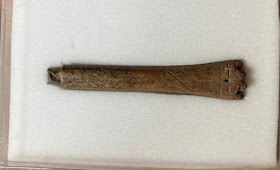Your impression of accessories may be beautiful and decorative, but have you ever thought about how they add beauty and style to our lives and serve a functional purpose at the same time? The Roman Bath houses a stunning collection of accessories spanning various historical periods. Reflecting on history, it becomes clear that accessories have long been a fusion of functionality and aesthetics.
Functional yet fashionable
In the Roman period, people already focused
on developing aesthetically pleasing and useful ornaments. Brooches were
particularly popular, and people used them to fasten their clothing. These
brooches came in various types, including the penannular brooch with an open
frame, the plate brooch prevalent during the first century, and the bow brooch
commonly found in Roman archaeological sites. Don’t think these two thousand
years ago ornaments are just simple copper alloys. On the contrary, they are
often very exquisite, with changeable shapes and colourful enamel surfaces.
 |
| Left to right: Roman plate brooch, bow brooch, and replica of a penannular brooch |
Expressions of belief
By the medieval period, in addition to
delicate metalwork techniques like inlay, enamelling, and filigree becoming
more common, their function began to reflect individuals' spiritual convictions
or to show people's faith. For example, before the trend of wearing bells
gained widespread popularity, it was mainly priests and pilgrims who adorned them,
thereby symbolising their affiliation with the religion. Pilgrims collected
various badges in different shapes to commemorate their pilgrimage and to
express their religions. Similarly, influential figures have often awarded
badges to their allies to commend their loyalty and support towards a certain
belief or ideology.
 |
| Left to right: Medieval dog badge and bell |
Symbols of taste
After the 16th century, with the development of craftsmanship, the styles of functional ornaments became more varied and popular. For instance, in the Georgian period, wigs changed from functional preventing head lice to a symbol of style. Following the Industrial Revolution, the advent of mass production brought about an increase in diverse and accessible ornaments, which were no longer considered a luxury reserved for the upper class alone. Buttons, once the exclusive of the nobility during the medieval era, became a commodity that could be easily moulded and mass-produced. With the rise of the bourgeoisie, the popularity of shirts gave way to the fashion of cufflinks. Though seemingly unremarkable at first glance, these functional items embody a sense of style, and the variety of their forms and materials showcase the wearer's discerning taste.
 |
| Left to right: Georgian wig curler, moulded metallic button, and cuff links |
Upon observing today's clothing, can you
think of other decorative features that are functional but also fashionable?
Maybe it is your stylish watch, glasses or even a zipper? Let us take a closer look
at our clothing and appreciate the practical and astonishing accessories that
have been thoughtfully designed.
Yushin
Placement student




































